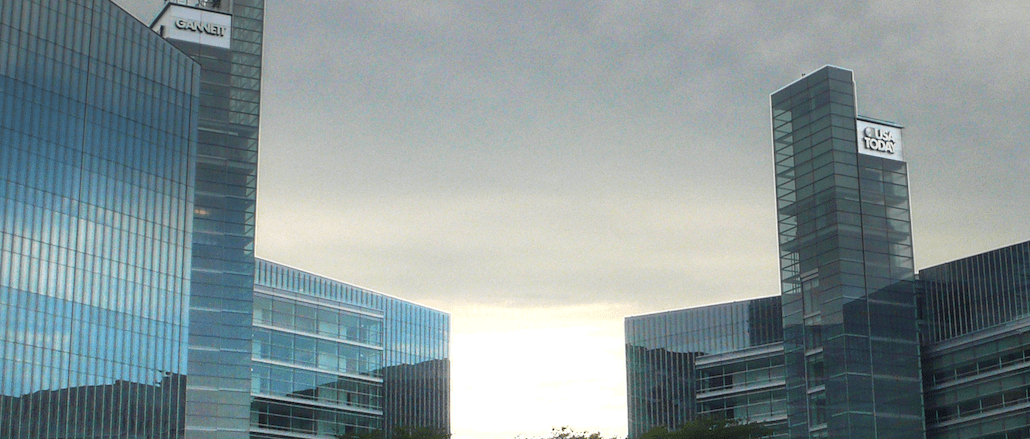Join us Dec. 1-3 in New Orleans for the Digiday Programmatic Marketing Summit

With the hire of former Washington Post and Yahoo exec Kevin Gentzel as its first-ever CRO, the newly spun-off publisher Gannett has signaled that it has great faith in that buzzword du jour — native advertising — and not a little hope for programmatic, too.
Gannett has just completed its spinoff, following in the footsteps of other media conglomerates (News Corp., Tribune, Time Warner, to name a few) that have split off their faster-growing broadcast businesses to shield them from their weaker print-publishing counterparts. The broadcast and digital businesses left over from the Gannett split belong to a new company, Tegna, whose name was composed of letters from the original Gannett name.
Like all legacy print publishers, the Gannett publishing company that has emerged is trying to expand its digital advertising to offset a longstanding decline in its core print business. Its publishing business revenue declined 8.8 percent to $768.2 million in the first quarter of 2015, on lower ad and circulation revenues. Broadcasting revenue, meanwhile, increased 3.8 percent to $396.8 million.
With Gentzel, Gannett is hoping to further tap marketers’ interest in so-called native advertising, the format that mimics editorial content. Spending on native is projected to more than double to $8.8 billion in the U.S. in 2018 from $4.3 billion in 2015, according to eMarketer.
Gentzel helped kick off the industry’s obsession with native ads while CRO at Forbes, where he introduced the AdVoice product, now called BrandVoice. That record led to his hire as CRO at The Washington Post. Most recently, he served briefly as head of advertising sales for North America at Yahoo. At Gannett, he’ll report to John Zidich, president of domestic publishing.
Native is well suited to brand-building campaigns, but it may be a tough sell for local papers whose clients are more interested in increasing foot traffic or seeing other direct results from their ads. Gentzel said he sees opportunity in a branded content strategy that mirrors the company’s move toward a centralized editorial approach across its 2,700 journalists, where articles and editorial expertise are shared to a greater extent. One manifestation of this is Project Butterfly, where USA Today creates a news section that’s inserted into local Gannett papers.
“There are ad products that could be developed for a local advertiser that could resonate and work for a national advertiser, and we could take learnings for national advertisers and apply them in a way that works for local advertisers,” Gentzel said. “To my knowledge, it just hasn’t been done much anywhere.”
Beyond native, Gannett has also introduced intrusive takeover units called Gravity ads; Wednesday, it will extend the format to mobile. Programmatic ad sales, which have been viewed with suspicion by salespeople who worry that automation will threaten their jobs, also will be a focus. “Programmatic requires real sales skills and sales power,” Gentzel said, referring to that fear.
But while newspapers need to do something to make up for the $1 billion revenue loss they face this year, Gannett will be challenged doing native advertising on a local level, said Colby Atwood, president of Borrell Associates, a media research and consulting company.
“People who read local newspapers are reading them for local information,” he said. “When you read native advertising that’s created centrally, it sticks out. Readers will be more sensitive to it, so there’s going to have to be some effort to make it as seamless as possible.”
Gentzel’s appointment is another step toward centralization at Gannett, which consists of the flagship national newspaper USA Today and 92 local dailies. The centralization has already happened with circulation and distribution. On the edit side, Gannett plans to name a new chief content officer to replace Larry Kramer, the former publisher of USA Today who was to continue as chief content officer of the company after the split until he decided to retire instead. The chief content officer will have oversight of all the papers’ editors, through a corporate editor-in-chief.
More in Media

Forbes launches dynamic AI paywall as it ramps up post-search commercial diversification plans
For the latest Inside the publisher C-Suite series, Digiday spoke to Forbes CEO Sherry Phillips on its AI-era playbook, starting with its AI-powered dynamic paywall to new creator-led commercial opportunities.

Creators embrace Beehiiv’s push beyond newsletters
Creators are embracing Beehiiv’s new website, product and analytics tools to help them grow beyond the competitive newsletter space.

Media Briefing: Publishers turn to paid audience acquisition tactics to tackle traffic losses
Publishers facing declining organic traffic are buying audiences through paid ads and traffic arbitrage, and using AI tools to do it.





